Higher levels of economic growth in Mongolia have led to a greater demand for power supply. As the country is mostly reliant on coal for energy, serious air pollution has also become a pressing issue. JICA helped address these problems through its support for the Tsetsii Wind Farm, the second wind power generation project in Mongolia.
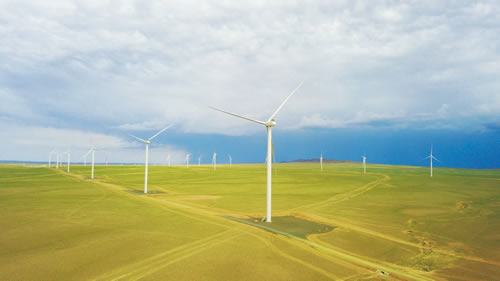
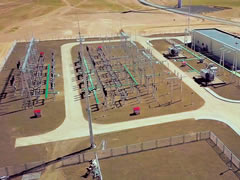
The substation of the Tsetsii Wind Farm. Pictured is the facility for voltage regulation.
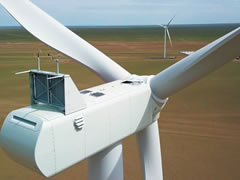
Each wind turbine can produce 2 megawatts.
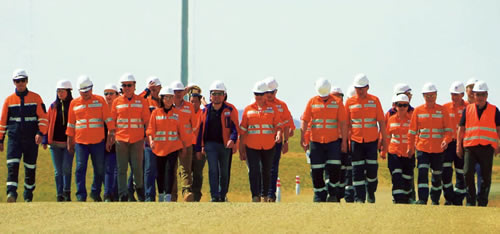
95% of the 500 personnel involved in the construction of the wind farm were Mongolians. This partnership between the two countries to build high-quality infrastructure also contributed to the local communities.
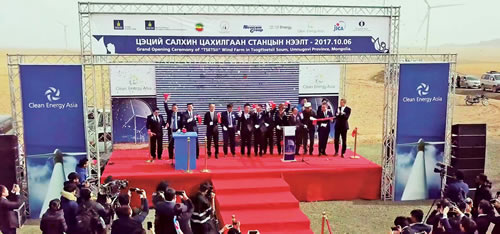
The completion ceremony was held in October 2017.
Wind Power Generation Project with Environmental and Economic Benefits
In recent years, Mongolia has experienced dramatic economic growth. Even though the rate of domestic power generation is increasing, it has proved inadequate to keep up with demand for power supply, and the current shortfall in supply is mostly met by purchasing electricity from Russia.
Approximately 90% of Mongolia's total power is generated by coal-fired power plants. However, the burning of raw coal in thermal power plants using small boilers and for winter heating facilities, combined with poor combustion efficiency from the aging thermal power plants, has led to an increase in air pollutants and greenhouse gas emissions.
Amidst calls to promote the use of renewable energy to deal with such problems, two companies, Newcom LLC, the pioneer company in constructing and operating wind power plants in Mongolia, and SB Energy Corp., a Japanese renewable energy company, have jointly created Clean Energy Asia LLC. Clean Energy Asia finished the construction of the Tsetsii Wind Farm, the country's second wind farm, three months ahead of schedule. Operating since October 2017, the wind farm is located in the Gobi Desert, an ideal site for generating wind power because westerlies prevail year round. "Not only does it reduce greenhouse gas emissions, it also brings economic benefits because the marginal operating costs required for aging thermal power plants are by far higher than those required to operate renewable energy plants," says Clean Energy Asia's Enkhtuvshin Turbold. [1]
First Overseas Investment in the Field of Natural Energy
With 25 giant wind turbines standing at 130 meters, the Tsetsii Wind Farm can generate 50 megawatts, enough to cover approximately 5% of Mongolia's energy requirements. It is financially supported by JICA together with the European Bank for Reconstruction and Development (EBRD). JICA is providing support through its Private-Sector Investment Finance [2] in the field of natural energy. Mr. Turbold elaborates, "The Mongolian economy basically came to a standstill in 2016. Both foreign investors and international development financial institutions abandoned the Mongolian market, and some put their investments on hold. It is thanks to JICA's financial support that this project materialized."
"There are plans to develop a multinational power grid primarily generated by renewable energy that will supply power to East Asian countries. With its prevailing westerlies and the abundant solar energy, the southern Gobi region will become an important producer of energy. We are working to make the Tsetsii Wind Farm the main supplier since its capacity can be expanded to 250 megawatts," says Mr. Turbold on the future of Asia and Mongolia.
Notes
- [1]The Tsetsii Wind Farm project has the potential to reduce Mongolia,s annual CO2 emissions by 176,575 tons; equivalent to approximately 1% of Mongolias total CO2 emissions.
- [2]This scheme provides support in the form of loans or financing for private companies carrying out projects in fields such as infrastructure development, elimination of poverty, and climate actions, which have high development potential. It aims to enhance the impacts of development, while reducing business risk through technical cooperation and collaboration with private and international financial institutions.
Enkhtuvshin Turbold
Finance Manager, Clean Energy Asia LLC
Completed his master's degree at the Graduate School of Economics, University of Tokyo. Joined Clean Energy Asia LLC after working at the Trade & Development Bank of Mongolia.
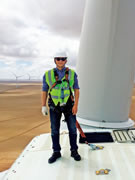




scroll